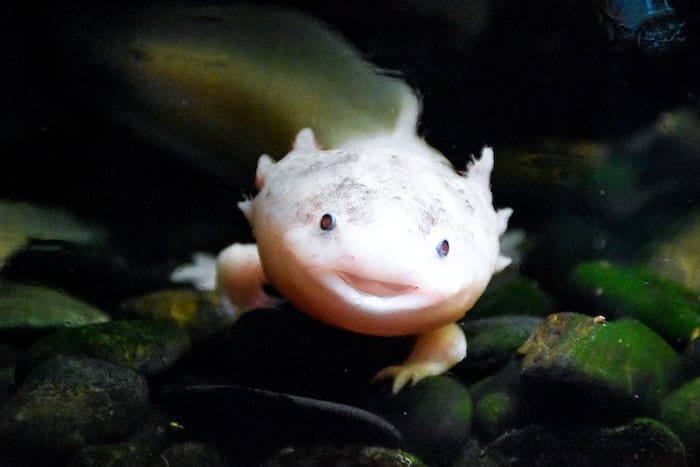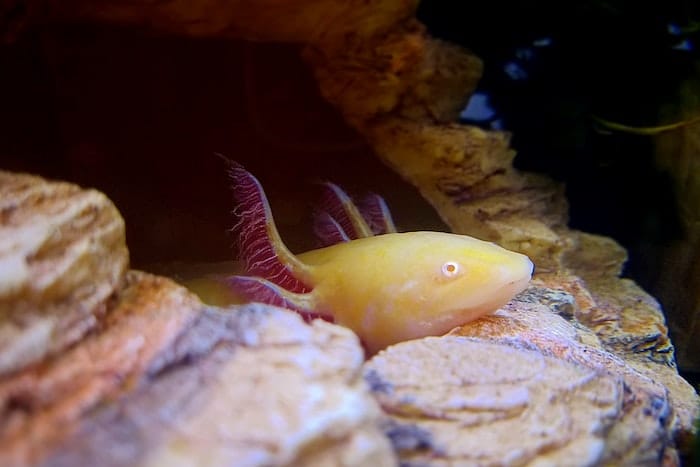Axolotl morphing is a very serious concern for many owners. It can severely impact the health and lifespan of an axolotl and change how you must look after them.
Is it possible to prevent your axolotl from morphing? Here we are going to look at axolotl morphing and find out more about why it happens and what can be done about it.
What Is Axolotl Morphing?
Morphing is a short-hand term for metamorphosis. Most animals go through one form or another of metamorphosis throughout their lifespan.
Humans go through their own morphing as we grow older, and hormones begin to affect our growth and make changes in our bodies. Changing from a child to a teenager can be considered a metamorphosis in human beings.
Axolotls can morph in their lifespan, most often as they change from juveniles to adults much like humans do. The changes they go through can be quite significant, with physical changes to their features and to the size of their body, as well as color changes in some cases.
Not all axolotls will morph but when one does it can be quite stressful to their body and change the way they behave, and even what they eat. In many cases axolotl morphing can change an axolotl from a water-dwelling amphibian to a terrestrial axolotl, spending its time on dry land instead of in the water.
You can learn more about axolotl morphing and the changes you can expect to see if your axolotl morphs. There is a lot to find out if you want to take the best care possible of your pet axolotl if it goes through a metamorphosis.
Is My Axolotl Morphing?
There are some common signs of axolotl morphing that every owner should know. Spotting the signs early can help you to prepare for your pet’s metamorphosis and make it less stressful for them.
During a typical axolotl morph, you will notice changes to the size of the eyes, fins, and tail of your axolotl. The eyes usually bulge out and grow larger and will begin to develop eyelids. This changes the appearance of an axolotl’s face, and the head will usually become bigger to accommodate the bigger eyes and lids. The head will grow larger in proportion to the body.
The dorsal fin and tail fin will usually shrink too, increasing the change in size and shape of your axolotl. Morphing axolotls often lose their fins completely, and their tails can decrease in length too. This affects the movement of the axolotl, as it can no longer swim as well as it used to.
What Causes An Axolotl To Morph?
Morphing should be prevented if possible, so it is important to know how metamorphosis can be triggered by an axolotl’s environment and diet. This will help you take steps to reduce the chances of your pet axolotl going through a metamorphosis, risking its health, and reducing its lifespan.
Axolotls that have morphed may only live for a few months after going through the process. The changes that a dramatic metamorphosis causes to an axolotl are difficult for them to adapt to and challenging for their owners as well. Preventing an axolotl from morphing can preserve the life of your pet and let you get more enjoyment from looking after them for longer.
Morphing in axolotls is caused by a hormone produced in their brain called thyroxine. Production of this hormone can be triggered naturally as a part of the axolotl’s development, but exposure to iodine can also trigger thyroxine production.
This can make an axolotl morph unnaturally, and some people do this on purpose to witness a morph and see how their pet will change. This is not recommended, the best way to care for your pet axolotl is to allow it to live its natural life, possibly never morphing at all.
How Can I Prevent My Axolotl From Morphing?
Some axolotls will morph in their lifetime, and this should be allowed to happen if it is a part of your pet’s development. There are steps you can take to reduce the chances of axolotl morphing, which helps to extend the lifespan of your pet.
Reducing the chances of iodine contamination in your axolotl’s environment can help prevent a metamorphosis. Some live insects can contain iodine, so giving your axolotl a varied diet can help cut down on their iodine levels. You should also try to vary the source of your axolotl feed where possible.
Water can contain iodine, which you can test for. Tap water tested for iodine levels and then left standing for 24 hours before being introduced to your axolotl’s environment. Most tap waters contain chlorine, which is hazardous to axolotls. Leaving it to stand allows the chlorine to evaporate from the water, reducing its chlorine level.
What Do Axolotls Morph Into?
Most axolotls will morph from aquatic creatures to ones that spend their time on land, known as terrestrial axolotls. This is a massive change in the behavior of an axolotl and will require changes in how you care for it.
The axolotl will need an environment that provides both dry land and some water, as well as places to explore to keep them active. Axolotls like to hide in shade to rest, so any environment you make for a morphed axolotl needs to have places they can stay hidden like pipes or caves.
Terrestrial axolotls like to dig a little and create small trenches and divots to rest in. Having a soil or substrate that is suitable for axolotls and can be moved and dug through easily is important. Peat is good soil for this. Its wetness helps to contribute to the humidity and keeps your axolotl moist. Any soil or substrate needs to be acid-free to protect the skin of the axolotl.
The chances of your axolotl morphing can be greatly reduced if you monitor the levels of iodine in their environment. Some axolotls will morph, so you should be prepared if it happens and know what to do.
This guide should have given you plenty of ideas on how to prepare for axolotl morphing and how to reduce its chances of happening.
Related Reading


